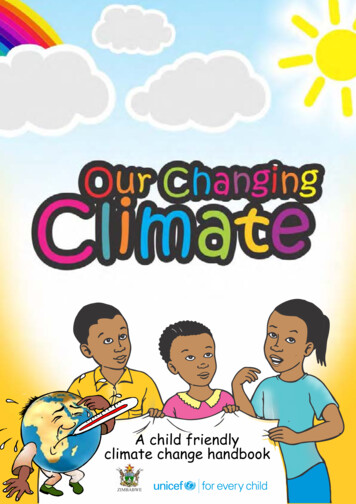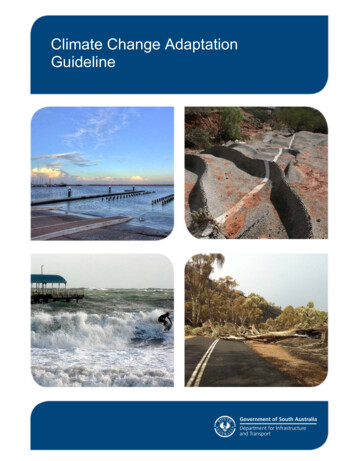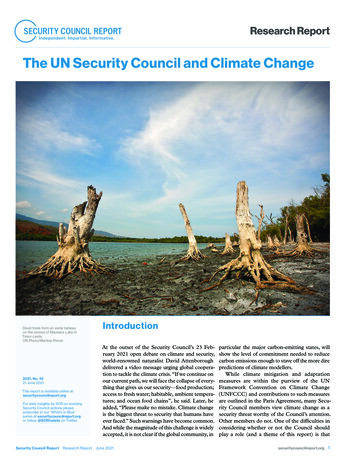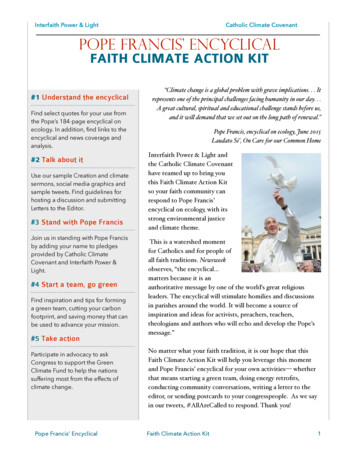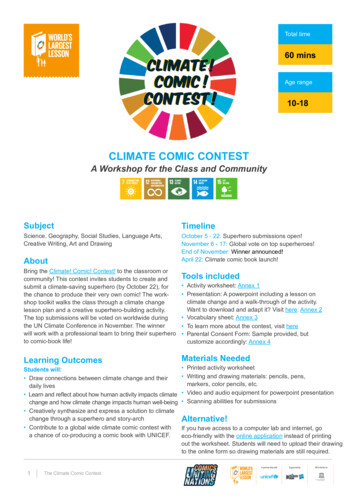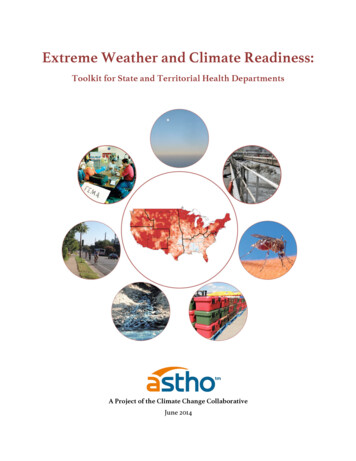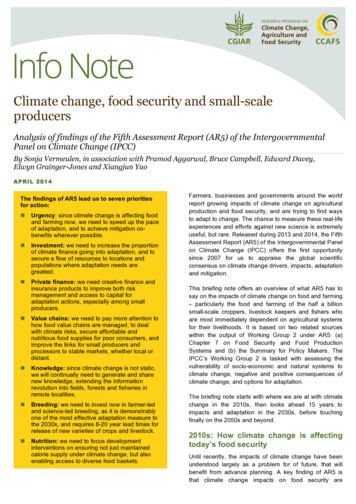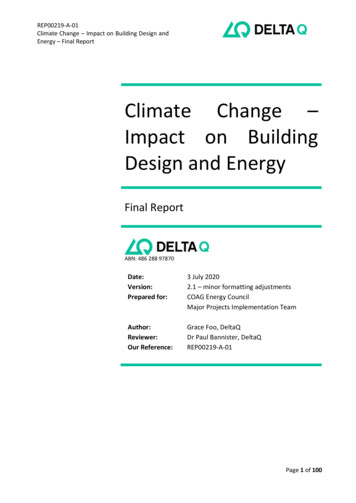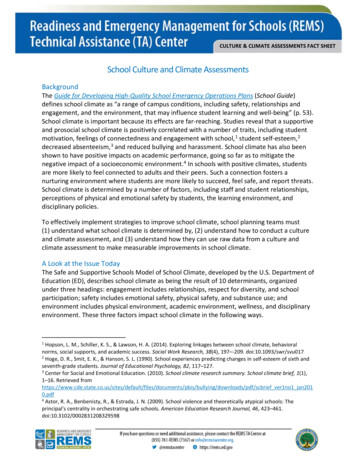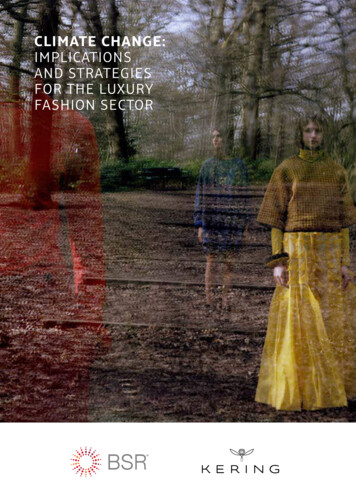
Transcription
ClimateClimate Change:Change:ImplicationsImplicationsandand StrategiesStrategiesforfor thethe LuxuryLuxuryFashionFashion SectorSectorseptember 2015
03ContentsKERING & BSRFOREWORDFOREWORDFOReWORDpage 03ABOUT THIS REPORTpage 04executive summarypage 07INTRODUCTIONpage 11climate change risksfor luxury fashionpage 13The raw materialimperative: understandingclimate’s impactspage 18the way forward:a resilience agendafor luxury fashionpage 29CONCLUSIONpage 41raw material hotspot mapspage 43glossarypage 55referencespage 57As a society, we arefacing enormouschallenges from theinevitable impact ofclimate change.To mitigate this impact and adapt to these changes, thereare important contributions that we can make as individuals,in civil society, and in the public and private sectors. Thebusiness community has a particular responsibility to act.I am pleased that there are some excellent opportunities toalign around specific initiatives through the upcoming COP21in Paris and the newly launched framework of the GlobalSustainable Development Goals. Beyond doubt, businesscan and has to drive change. We can replace the outdated‘compete and consume’ business models with ones thatare ‘collaborative and regenerative’ and that build resilienceacross our supply chains.The first step in making this change is to identify climatepriorities across the business. Companies need to map andunderstand their complex supply chains and measure theirimpact. This will reveal both risks and opportunities, and willenable prioritization of actions and monitoring. Accordingto the Carbon Disclosure Project (CDP), around 50 percentof an average corporation’s carbon emissions come fromthe supply chain. At Kering, our own Environmental Profitand Loss (E P&L) account has shown us that the majority(67 percent) of our carbon emissions occur in raw materialproduction and its initial processing stages. Clearly this is thearea in a business’ activities on which to focus significantattention and action. With this in mind, our ‘Climate Change:implications and strategies for the luxury fashion sector’report aims to shine a light on the risks and opportunities ofclimate change in the provision of key strategic raw materialsfor the luxury fashion sector.Fashion companies rely on agricultural production fortheir raw materials. This is where climate change will havesignificant consequences through temperature changes,water scarcity, and impact from catastrophic climaticevents, such as cyclones and droughts. Luxury fashion hasadditional vulnerabilities because raw material quality iscritical to create outstanding products and because someof these materials derive from nature-based systems andecological processes that can be easily disrupted by climatechange. As such, our report focuses on six key raw materialsfrequently used by the luxury fashion sector and highlightsgeographic and thematic priorities, giving background asto why particular materials are more or less vulnerable toclimate change. Additionally, the report highlights how tobuild resilience in our supply chains through enhancedefficiency and innovative approaches for raw materialproduction. It outlines some of the key actions and solutionsthat are already available for businesses, including workingwith primary producers to develop agricultural systems thatincorporate reduced emissions and dependency on waterand that offer diversity of livelihood options.Through this in-depth climate change analysis, we cansee that the impact of climate change is already locallypronounced on the production of some raw materials andthat climate change trends show an increase in such risks.Undoubtedly, without an active strategy, it would also leadto an impact on the bottom line. In addition, it is clearthat the broader social consequences of disruption on rawmaterial production will be significant, particularly as ruralcommunities, which are already fragile, are a large producerof raw materials.For Kering, the analysis of climate change risk summarizedin our report is essential to help us develop appropriate,innovative, and robust business approaches and actionsto respond to climate change. Our report is also significantas it is the first time there has been a specific focus on theluxury fashion sector, which aims to offer our customers themost desirable products, and its vulnerabilities to climatechange. It provides an opportunity for large multinationalbusinesses like Kering, where the supply chain is critical,to develop climate resilience both through emissionsreduction and adaptive approaches. This guidance willhelp reduce risk, ultimately providing us with importantbusiness advantages now and into the future. We hope thatour report can be a catalyst for other companies in luxuryfashion, and the apparel sector more broadly, to build theirown roadmaps to climate change resilience. For businessestoday, implementing an ambitious climate strategy is nonnegotiable in order to remain successful in ourrapidly changing world.Marie-Claire DaveuChief Sustainability Officer and Headof international institutional affairs,Kering
0405KERING & BSRABOUT THIS REPORTKERING & BSRABOUT THIS REPORTABout this reportIn this report, BSR andluxury goods leaderKering highlight someof the key risks andopportunities posed byclimate change for theluxury fashion sector.The report provides an overview of climate change risksacross the value chain and demonstrates the importanceof addressing raw materials in any robust andambitious climate strategy.The report builds on information and analyses fromseveral sources: BSR’s climate strategy outlined in the publication,‘Business in a Climate Constrained World: Creatingan Action Agenda for Private-Sector Leadershipon Climate Change’1 (to be referred to as the ‘BSRClimate Framework’), which seeks to catalyzeprivate sector action in response to climatechange. In this report, the BSR Climate Frameworkis specifically adapted to the luxury sector and isused in the interpretation of climate risk mapping. Raw materials and climate-mapping data inthis report are based on an in-depth analysiscommissioned by Kering and carried out byVerisk Maplecroft2 in August 2015 (the ‘KeringMaplecroft report’). This analysis focuses on sixraw materials that are central to the luxury fashionsector—cotton, beef leather, sheep and lambleather, vicuña, cashmere, and silk. It evaluatesthe consequences of climate change on primaryproduction and initial processing locations. The Environmental Profit & Loss Account (the ‘EP&L’)3 is a natural capital accounting methodologypioneered by Kering and used to quantify thecompany’s environmental impact in terms ofgreenhouse gas (GHG) emissions and air pollution,water use and pollution, and waste and land usechange. It enables the company to identify risksand vulnerabilities (including around climatechange) across its vast global supply chainsand to prioritize its actions. It is a model of howcompanies can account for their impact anddependency on natural capital. A detailed literature review that was conducted toverify hypotheses and identify concrete cases tohelp illustrate climate change risks for companies.The intended audience for this report includes luxuryindustry executives, including C-suite business leadersas well as individuals in functions such as sourcing,product design, merchandising, marketing, sustainability,and philanthropy. The report is also intended for otherindustry stakeholders involved in evaluating climatechange risk and building adaptive business strategies.BSR and Kering intend that, as an outcome of this report,luxury fashion companies will be armed with increasedawareness of the consequences of climate change for theirbusinesses and will consider taking appropriate actionacross their supply chains to build new and more resilientapproaches. In particular, it is hoped that there will be anincreased focus on raw material production where climatechange will have a significant impact on agricultural andnatural ecosystems as well as on the communities thatdepend directly on these production systems for theirwell being and livelihoods.1 Cameron, E., Erickson, C., Prattico, E. and Schuchard, R., 2015.2 Verisk Maplecroft is a consultancy that helps organisations optimiseand strengthen their risk management processes and supply chainsby providing a full spectrum solution that blends an unparalleledportfolio of global risk analytics with world-leading analysis,real-time locational monitoring, and innovative risk calculatortechnology. Please see maplecroft.com for more information.3 For more information on the E P&L methodology, see kering.com.About BSRACKNOWLEDGEMENTSBSR is a global nonprofit that works with its network of morethan 250 member companies to build a just and sustainableworld. BSR develops sustainable business strategies andsolutions through consulting, research, and cross-sectorcollaboration. BSR’s climate strategy is to mobilize itsbusiness network, global reach, industry insights, and issueexpertise in support of sustained business action on climatechange through translation of climate risks, stabilization ofemissions, and collaboration to increase adaptive capacity.The authors wish to thank the following people for theirpeer review and feedback: Ben Packard, Beth Richmond,Edward Cameron, Eric Olson, Dr. Gemma Cranston, Dr. JamesAllan, Jean Jouzel, Jean Roger-Estrade, the Nicolas HulotFoundation, Dr. Richard Hewston, and Dr. Sissel Waage.About KeringA world leader in apparel and accessories, Kering developsan ensemble of powerful Luxury and Sport & Lifestylebrands: Gucci, Bottega Veneta, Saint Laurent, AlexanderMcQueen, Balenciaga, Brioni, Christopher Kane, McQ, StellaMcCartney, Tomas Maier, Sergio Rossi, Boucheron, Dodo,Girard-Perregaux, JeanRichard, Pomellato, Qeelin, UlysseNardin, PUMA, Volcom, Cobra and Electric. By ‘empoweringimagination’ in the fullest sense, Kering encourages its brandsto reach their potential, in the most sustainable manner.Present in more than 120 countries, the Group generatedrevenues of 10 billion in 2014 and had more than 37,000employees at year end. The Kering (previously PPR) share islisted on Euronext Paris (FR 0000121485, KER.PA, KER.FP).About the authorsThis report was written by BSR experts Elisa Niemtzow,Dr. Emilie Prattico, Tara Norton, and Bryndis Woods andKering experts Dr. Helen Crowley and Christine DriscollGoulay. Any errors that remain are those of the authors.Please direct comments or questions to BSR’s ElisaNiemtzow at eniemtzow@bsr.org or Kering’s Helen Crowleyat Helen.crowley@kering.com.Photo credits: Craft of Use by Kerry Dean,London College of Fashion, and Shutterstock imageryDISCLAIMERBSR publishes occasional papers as a contribution tothe understanding of the role of business in society andthe trends related to corporate social responsibility andresponsible business practices. BSR maintains a policyof not acting as a representative of its membership,nor does it endorse specific policies or standards. Theviews expressed in this publication are those of itsauthors and do not reflect those of BSR members.SUGGESTED CITATIONCrowley, H; Driscoll Goulay, C; Niemtzow, E.; Norton, T.; Prattico,E; and Woods, B. 2015. ‘Climate Change: Implications andStrategies for the Luxury Fashion Sector.’ BSR WorkingPaper in collaboration with Kering. BSR, San Francisco.Published November 2015
07Ex ecutiv esummaryKERING & BSREXECUTIVE SUMMARYLuxury fashion brands,like many other companieswith global footprints,face the risk of businessdisruptions andincreasing costs dueto climate change.Across their value chains—from their supply chains tomanufacturing sites and from distribution centers to retaillocations—the impact of climate change is already beingfelt and will likely continue to worsen. Some of these impactsare common to other global businesses, such as potentialtransport and delivery disruption, resource scarcity, andchallenges of social change. However, the luxury sector isparticularly sensitive to climate change because it relieson high-quality raw materials and materials that comefrom natural and agricultural systems that are limitedgeographically and can be particularly vulnerable to climatevariations. It is clear that the fundamental value propositionof luxury fashion brands—that includes rare, high-qualitymaterials—is at risk in the face of climate change.While the report outlines the climate risks facing globalluxury fashion companies, it also focuses on the impact ofclimate change at the very base of the supply chain whereraw materials are produced and where the impact will besignificant on the natural and agricultural systems that deliverthese materials. Current and future climate risks around sixkey raw materials—cashmere, cotton, beef and calf leather,sheep and lamb leather, vicuña, and silk—are reviewed andpresented. Detailed analysis shows that climate change isalready having obvious effects on these materials and thatthis impact is likely to increase over time.‘Luxury fashion brands,’ as referred to in this report, includehigh-end, ‘soft’ apparel and accessories brands (as opposed to‘hard’ luxury, such as watches and jewellery), which are definedby products of exceptional quality and by the leadership positionand influence in society these brands hold.44 For more information, see Pinkhasov and Nair, 2014.
0809KERING & BSREXECTUTIVE SUMMARYClimate Change Risksfor Luxury FashionLuxury fashion companies face five main types of risk dueto the impact of climate change: input, physical, market,stakeholder, and regulatory.5 In light of these risks and thefact that the importance of different risks will vary overtime and over geographies, it is imperative that companiestake a deep look at their supply chains and operations tounderstand where they are exposed to risk from the directand indirect impact of climate change. Natural capitalaccounting methodologies, such as Kering’s E P&L,represent one way of measuring the impact and exposure.The Raw MaterialImperative:UnderstandingClimate’s ImpactAccording to the CDP, more than 50 percent of an averagecorporation’s carbon emissions typically are from its supplychain.6 The Kering E P&L also shows clearly that much of thecarbon emissions and overall nearly three-quarters of thecompany’s environmental impact is, in fact, at the base of thesupply chain. Within global supply chains, it is at raw materialproduction, extraction, and initial processing that businessessuch as Kering interface with agricultural and natural systems.And it is here that significant risks and opportunities need tobe addressed.For the luxury fashion sector, raw material quality isparamount. This presents a special vulnerability forcompanies when a changing climate can impact qualityas well as the availability of these materials. The E P&Lprovided the first insights into supply chain risk for Kering.Kering followed up on this by commissioning a more detailedreport from Verisk Maplecroft into the climate change risk andvulnerabilities of six key raw materials (the ‘Kering-Maplecroft’report). The highlights of this analysis are presented in thisreport. The research by Verisk Maplecroft focused on regionsof the world where the raw materials (particularly high-qualityvarieties) are produced, and it evaluates the impact of climatechange on these regions over the next 50 years and beyond.Regions that are likely to be significantly affected by climatechange are identified as ‘hotspots.’ Identified hotspots canbe consulted for each raw material, as projected for the timeperiod 2036-2060, in Figures 2-6.The Kering-Maplecroft study provides three important findingsfor the luxury fashion industry relating to raw materials: Climate change is already driving a reduced availability ofluxury fashion’s raw materials, and will continue to do so. The impact of climate change will likely escalate over timeand will lead to a reduction in raw material quality that willdrive significant business risks for the luxury sector. The consequences of climate change will also be evidentin negative effects on small-scale producers relying onraw material production for their livelihoods.Each raw material evaluated in the Kering-Maplecroft reporthas its own characteristic vulnerability to climate change(see Table 1). However, extra fine cotton, vicuña, andcashmere face particularly significant risks because of thelimited geographic scope of their production regions andtheir dependence on natural systems.KERING & BSREXECUTIVE SUMMARYThe Way Forward:A Resilience Agendafor Luxury FashionIt is imperative that companies develop a strategic approachto tackling the challenges posed by climate change risks totheir business and across their supply chains. Key to this willbe outlining a clear agenda to build resilient supply chainsfocusing on the prioritization of actions and mechanismsfor monitoring impacts. Background and guidance forthe development of a resilience agenda can be found intwo recent BSR reports.7 The context for the agenda is the‘resilience wedge’ approach, which outlines a suite of broadactions for the private and public sector designed to meet theambition of keeping global warming within the 2 C limit—anessential threshold to stave off the worst of climate change’sconsequences for both natural and social systems.8 Theagenda covers the dual aspects of resilience—mitigationand adaptation—by addressing GHG emission reductionefforts, as well as adaptive capacity-building measures. Thesemeasures are actions that companies can take to adjust theirpractices in their own operations, or in their value chains, toproactively manage risks and seize opportunities associatedwith climate change.9In brief, there are three critical actions luxury fashioncompanies can take to build resilience and manageclimate change risks:1) Invest in targeted raw material resilienceThis involves a three-step process for companies: 1) first,identify raw material priorities by mapping supply chainsagainst climate change risks; 2) then take action and settargets with supply chain partners and other stakeholders;and 3) finally, monitor impact.2) Prepare your operations for a lowemissions futureLuxury fashion brands can swiftly contribute to the new lowemissions economy by reducing their own GHG emissions andby implementing measures at key points in their value chainsthat facilitate adaptation. In addition to a focus around rawmaterial production and processing, key areas for attentioncan include: 1) product design and manufacturing; 2) moreeffective energy and fuel management in manufacturingfacilities, offices, stores, and logistics; 3) working on theefficient siting of facilities and stores; and 4) investing inand procuring from suppliers that are climate resilient.3) Make climate action irresistibleLuxury fashion brands can harness their leadership positionas ‘influencers’ to build awareness of and excitement arounda climate-smart world. Luxury brands can catalyze action onclimate change through their clients, as well as more broadlyin the public sphere.7 Cameron, E., Erickson, C., Prattico, E. & Schuchard, R., 2015, andNorton, T.; Ryan, M.; and Wang F., 2015.5 For more information on climate risks to business, see Cameron, E.,Erickson, C., Prattico, E. and Schuchard, R., 2015.6 A.T. Kearney, 2011.8 For more information on the 2 C limit, please see Cameron, E.,Erickson, C., Prattico, E. and Schuchard, R., 2015.9 For more information on resilience and adaptive capacity, pleasesee Cameron, E., Erickson, C., Prattico, E. and Schuchard, R., 2015.
11I N TR O D UCTI ONKERING & BSRINTRODUCTIONAs the reality ofclimate change setsin, all businesses,including luxury fashionbrands, must nowconsider how to operatein a rapidly changingand volatile world.The leading body for the assessment of climate change,the Intergovernmental Panel on Climate Change (IPCC)—to which thousands of experts contribute voluntarily—reports that the observed impact of climate change isalready widespread and consequential.10 Climate changehas led to devastating impacts from storm damage, foodinsecurity through crop failure, growing water scarcity,and increased risks to human health and productivity.11To protect the quality and availability of their productofferings, luxury fashion brands must now consider actionsto build resilience in their businesses in the face of climatechange threats. BSR’s Climate Framework defines building‘resilience’ as: 1) implementing a series of measures thatallows a company to reduce the full suite of GHGs and otherpollutants that cause climate change, while 2) buildingadaptive capacity in the face of inevitable climate impacts.16A truly resilient global business builds ‘adaptive capacity’ bylooking to avoid unmanageable climate change (for example,by reducing emissions across its value chain and investing inREDD projects) and by trying to manage unavoidable climatechange (for example, by investing in green infrastructure,building climate-proof facilities, focusing on the climateresilient production of raw materials, and working with localcommunities in their value chains). This report highlightssome of the climate change risks luxury fashion companiesare facing and outlines some approaches to adapt to theserisks by building resilience into value chains. Through its owncommitment, the luxury fashion sector can then also leverage itsleadership position to catalyze broader positive climate action.The report has the following structure:For business, these effects translate into tangible costsas evidenced by the 67 billion dollars of damage due toHurricane Sandy12 in 2012 and the 32.5 billion of damageand losses to the manufacturing sector in Thailand followingsevere flooding in 2011.13 Like many other consumer goodscompanies with global footprints, luxury fashion brandsface risks in their supply chains, distribution centers, retaillocations, and consumer base due to climate change.14This report aims to help luxury fashion brands focus onand understand some of these risks and to give somepreliminary guidance on ways of responding to these risks. First, it gives an overview of the most important climaterelated business risks facing luxury fashion across itsvalue chain.What is meant by ‘luxury fashion’? In this report, the focusis on high-end ‘soft’ apparel and accessories brands (asopposed to ‘hard’ luxury that includes watches and jewellery).Luxury fashion is defined by products of exceptional qualityand by the brands’ influence in society.15 At the heart ofluxury fashion lies a considered and refined product. Luxurybrands rely on high-quality and precious raw materials andhighly skilled people to create exceptional products. The valueof luxury brands is driven by their ability to connect withtheir clients’ dreams and aspirations, while setting trendsand creating ideals. Many luxury clients are also influencersthemselves, offering the sector a distinct and visible positionin society. Third, it proposes a ‘resilience agenda’ for luxury fashionthat includes individual, company, and collaborativeactions to reduce climate risks and strengthen capacityto adapt to climate challenges, especially in raw materialsourcing where the sector is so vulnerable. Second, it focuses on an area in the supply chain whererisks from climate change are arguably the greatest forluxury fashion—risk to raw materials—by reviewingresults from the Kering-Maplecroft study, which evaluatesthe climate change risks associated with the productionof cotton, cashmere, vicuña, beef leather, sheep and lambleather and silk.10 IPCC, 2014.11 Ibid; Bloomberg, Paulson and Steyer, 2014.12 NOAA, 2014.13 World Bank, Government of Thailand and GFDDR, 2012.14 Wong and Schuchard, 2011.15 For more information, see Pinkhasov and Nair, 2014.16 Cameron, E., Erickson, C., Prattico, E. and Schuchard, R., 2015.
13Climat eC han ge Risksfor LuxuryFashionKERING & BSRclimate change risks for luxury fashionthe impact of climatechange is likely tobe ‘severe, pervasive,and irreversible’ as aresult of increased,unprecedented GHGconcentrations inthe atmosphere,17according to the IPCC 5th Assessment Report (AR5),the repository of the most reliable scientific knowledgeon climate change under the auspices of the United Nations.This rapidly changing climate can affect business ina variety of ways:18 Climate-related hazards, such as an increase in theintensity and frequency of extreme weather events likehurricanes and droughts and changes in precipitationpatterns affecting the availability of water;19 and The vulnerability and exposure of natural systemsand human livelihoods to climate change, includingthe loss and degradation of biodiversity and ecosystemservices (such as water filtration, soil replenishment,crop pollination) as well as related social consequences(such as loss of livelihoods).The result of these impacts of climate change isa series of risks to business:20 (See overleaf)17 IPCC, 2007.18 Cameron, E., Erickson, C., Prattico, E. and Schuchard, R., 2015.19 IPCC, 2007.20 For more information, see Cameron, E., Erickson, C., Prattico, E. andSchuchard, R., 2015.
1415KERING & BSRclimate change risks for luxury fashionKERING & BSRclimate change risks for luxury fashion12345input risksPhysical risksmarket risksstakeholder risksregulatory risks Definition: Risk to the availability,quality, and cost of raw materialsand inputs that are used for acompany’s products. Definition: Risk to the securityof and access to a company’sown operations and assets. D efinition: Risk that there willbe changes in market demandcreated by climate change. Thisincludes potential changes indemand for specific productsas well as in the effectivenessof marketing messaging. Definition: Risk that comes fromfailing to deliver against expectationsfrom stakeholders who careabout the changing climate. Definition: Risk of changingregulations that result from arising price on high carbon sourcesand the energy intensive activitiesthat depend on them. Theseregulations, though they concernclimate primarily, have an effecton the broader regulatory landscapetoo, including policies on air qualityand on the protection of biodiversity,natural systems, and water. Example: This report goes intodetail about ‘input risk’ linked withraw materials themselves in thenext section. However, it is alsoimportant to think about the ‘indirectinputs’ that go into the productionof raw materials, processing, andmanufacturing. Water, for example,is such an input, and climate changewill affect water availability. Cotton,leather, textile manufacturing,and garment production all relyheavily on water. For manufacturing,supplier factories located in waterstressed regions will face increasedcompetition and regulatoryrequirements for water. Example: Extreme weather eventsresulting from climate changecan impede manufacturingoperations and disrupt anddelay the transportation of rawmaterials and finished products.Extreme weather can also affectthe livelihood and mobility ofpeople, which could increaseworkforce instability in operationsand supply chains and impinge onconsumers’ access to retail stores.22 Example: The way products aredesigned and conceived will need tochange. For example, it may becomeincreasingly relevant to considerproducts that work well with lessdistinct seasonal changes andwarmer temperatures. Also in termsof marketing, as climate changecreates more and more impacts,brands may want to express theircommitment to mitigating climatechange in different ways. The newclient segments that are drivingluxury brand growth are Millennialsand ‘Aspirationals.’ Aspirationalsrepresent 51 percent of consumersin China, love shopping (93 percent),and want to do so responsibly (95percent).23 Brands that ignore thisnew consciousness risk maintainingan outdated positioning.21 FAO, 2015; Cotton Incorporated, 2015.22 Mellery-Pratt, 2014.23 Baranowski and Miller, 2014.24 Divestment is the opposite of investment; the removal ofinvestment capital from stocks, bonds, or funds. The globalmovement for fossil fuel divestment asks institutions to movetheir money out of oil, coal, and gas companies for both moraland financial reasons. For more information, see Howard, 2015.25 The Dow Jones Sustainability Indices were launched in 1999as the first global sustainability benchmarks. The indices areoffered cooperatively by RobecoSAM and S&P Dow Jones Indices.The family tracks the stock performance of the world’s leadingcompanies in terms of economic, environmental, and socialcriteria. The indices serve as benchmarks for investors whointegrate sustainability considerations into their portfolios, andprovide an effective engagement platform for companies whowant to adopt sustainable best practices. For more information,see sustainability-indices.com. Example: Just as luxury brandsface evolving consumer needs andexpectations, they also face theinfluence of other key stakeholders,such as civil society, employees,and investors, who increasinglyhave concerns about climateperformance. For example, thedivestment movement24 has shownhow many stakeholders are holdinginvestment portfolio managers andcompanies accountable for climateimpacts. Investors themselves,a key stakeholder for luxury, areincreasingly including climaterisk in their decision-making bytaking into account metrics suchas the Dow Jones SustainabilityIndex25 and transparency onreporting climate risk. Example: In 2008, Chinastrengthened regulation for theprevention and control of freshwater pollution and use of waterresources via amendments to its2002 ‘Water Law’. This law providesmore stringent penalties forpolluters; a wastewater dischargepermit system; the option for citizensto bring class-action suits againstpolluters; improved water qualitystandards; increased transparency;and penalties for inadequategovernment enforcement.Consequently, companies that relyon water-intensive processes havehad to adapt to a shifti
climate change in the provision of key strategic raw materials for the luxury fashion sector. fashion companies rely on agricultural production for their raw materials. this is where climate change will have significant consequences through temperature chang

